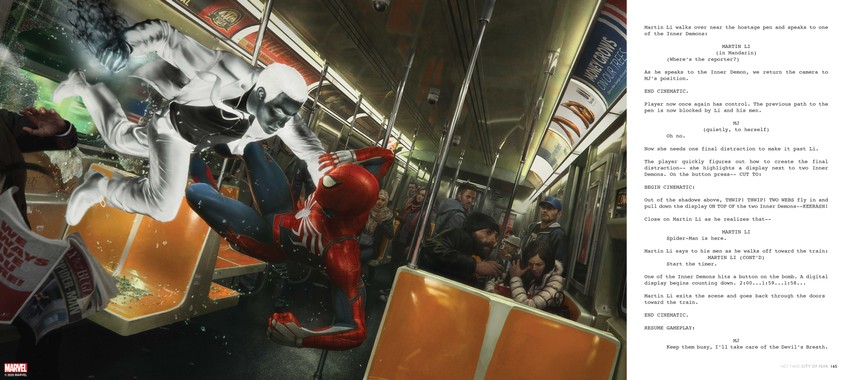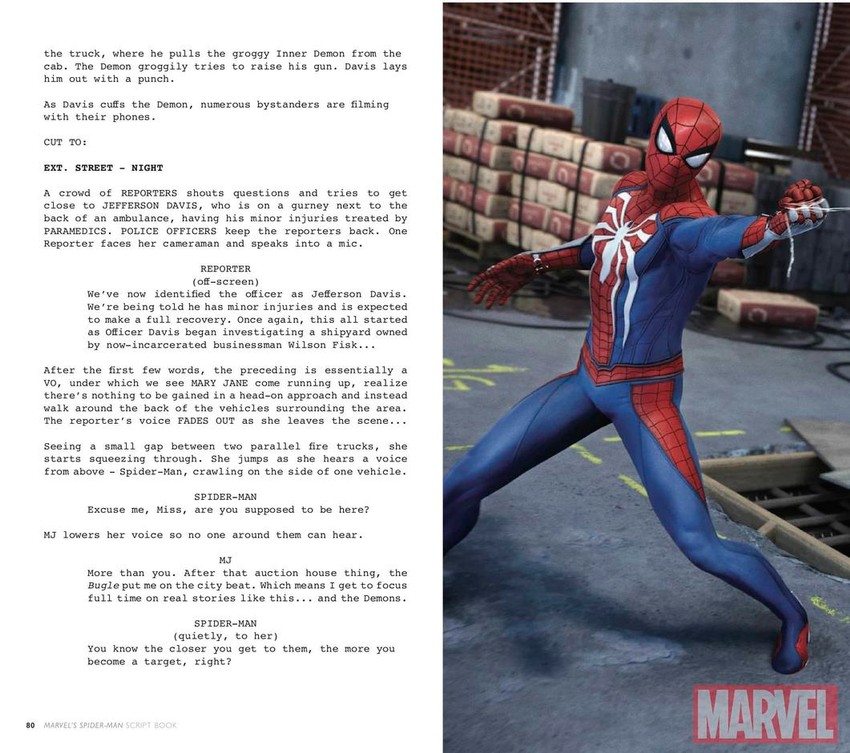MiyazakiHatesKojima
Banned

'Spider-Man' Developers Want More People to Know How Games Are Written
A 240-page script book is an attempt to demise one part of the messy, confusing creative process that results in a video game.
"I get asked all the time, usually from students, 'What does a video game script look like?'" said Jon Paquette, lead writer on 2018's Spider-Man. "[They say] 'I want to get my hands on one so I can learn what you guys do and how I can maybe become a game writer one day.'"
Paquette and I were speaking about a unique collaboration between Sony, Insomniac, and Marvel: a hardcover book with the story script for Spider-Man. The book came out last week, and provides a look at one of the more important aspects of why the game was so beloved. The book itself is not every word that was written for the game because that would be unruly and unreadable, instead focusing on the cutscenes. Paquette estimates Insomniac's writing team wrote roughly 800,000 words for Spider-Man, of which half made it into the game.
"I did a tally at one point," said Paquette, "where I looked at the page count, if he would've put it all into a book, and it would be longer than the Lord of the Rings trilogy. [laughs]"
Barnes and Noble lists a Lord of the Rings Trilogy, albeit including The Hobbit, at 1,504 pages. What's featured in Spider-Man's script book tops out at a "mere" 240 pages.
Part of the reason the book doesn't include every last piece of writing included in Spider-Man is because video games require writing for so many elements that players aren't aware of, like, say, the 10 different ways a character can say a similar line in different ways, depending on the context of the situation (are they mad or happy?) and to avoid endless repetition.

"We have an online database where we put all the scripts into," said Paquette. "Some of those scripts are just cinematics that are more linear, like you're used to in a film or a TV script. Some of the scripts that we put in the database are just thousands of lines of dialogue."
Paquette, who's worked at Insomniac for more than 10 years, got started in games long before writing was important, yet alone a separate discipline requiring specific skills. He came into the industry through quality assurance, trying to work out the bugs on games, famously working on titles like the ambitious Jurassic Park game, Trespasser, calling it "quite the project."
"I came into the game industry as an intern back in 97," he said. "I was at grad school for screenwriting, and there was a little advertisement there for free games and free food, but no pay. And I was like 'That sounds like a dream to me.'"
He eventually transitioned into design, working as the creative director on Medal of Honor: Airborne, before coming to Insomniac during the production of Resistance 3. Spider-Man, though, was the most daunting task in front of Paquette yet; he came into the game as a massive fan—his childhood subscriptions were to Spectacular Spider-Man, Amazing Spider-Man and Thor—and was now in a position to start telling their own Spider-Man story.
"I don't remember the exact line, but I remember the moment," he said, trying to recall the first line he wrote in the script. "I was actually at home, it was probably a weekend or something, and I remember typing 'Spider-Man' man for the first time in a character slug and being like, 'Oh my god. This is real'," and I paused, I went to my wife and I said, 'Hey, I'm writing Spider-Man.' And then I just went back into my office and continued writing."
Insomniac's take on the popular Marvel character was celebrated not just for how joyous it was to swing around the city of New York, but for telling a damn good Spider-Man story, too. It punted straight past the origin story, starting eight years into superhero-ing, and grounded Peter Parker's reality with some fresh twists, such as Mary Jane working at the Daily Bugle.
Paquette was not the only writer who contributed to the game, either. It was a group effort involving several other writers, and Paquette actually includes the "designers" as writers, too.
"The other part is writing the [game] experience," he said. "This is the part that not a lot of people really understand. It's very collaborative. We work for the designers in this capacity, because the designers come up with the gameplay and we help them structure the experience."
You can actually see this in the script itself, the balance between the two worlds:
We CUT TO:
OUTSIDE
THWIPTHWIP! A pair of webs shoot out from the window, and a moment later— SPIDER-MAN! Only NOW do we see him in all his glory, lit by the rising sun, as he swings into morning in Manhattan. After a wallrun, we'll end the cinematic with Spider-Man jumping into the air seamlessly handing control to the player mid-swing.
BEGIN GAMEPLAY:
"We actually do a lot of usability testing," said Paquette, "and we ask them specific questions like, 'Do you know what your objective is here? Do you understand why you're doing this one thing?' and when they say 'No, I have no idea but it's super fun.' Then, I'm the one that failed there. So then I need to go back and say 'Okay, how can we help the player understand exactly what it is that they need to do?'"
That also means the script is in flux all the time. What appears in the book is the final draft, and not reflective of the hundreds of thousands of words that changed over the game's several years of development, the plots and characters that were imagined and tossed out. The story dictated the gameplay, and the gameplay dictated the story. It's a lengthy dance.
"I remember a day," said Marvel Games creative director and VP Bill Rosemann, "we walked in and there was a whole wall filled with little note cards. Each note card was a story beat, and we had the entire game played out. We're looking at the story and realized "hey, this moment is really cool. Feels like it belongs over here."' They just row [of note cards] and shifted them."
"They say writing is rewriting," said Paquette. "I don't think it's more ever more the case then then in game writing."

An art book detailing the creative process for the game's look was released days after Spider-Man itself did, which has quietly become commonplace for video games, largely because it's such a visual medium. But there aren't books with the scripts for the story, or the design documents outlining how a game fundamentally works. They're all important pieces.
After the art book was released and it became clear the story was resonating with players, Paquette asked if there was a way to more widely distribute the game's script.
"We started talking about it," said Rosemann. "'Is that possible? Can that be done?' And then someone said 'That's ever been done before.' And I said, 'Well, great, we loved it [the script] at Marvel. Whatever hasn't been done, so let's try it."
The result is an undeniably rare look at part of the game development process that's often overlooked. It's not reflective of the path Insomniac took towards the final script, but it's nonetheless a notable document for anyone who wants to understand where games end up.
"I felt like there was a little bit of responsibility on us to share all the hard work that we did,," said Paquette," and hopefully educate some people out there. But at the same time, I was also surprised how many of my colleagues at other studios were like, 'oh, man, you guys are publishing the book? That's amazing. We should do that, too.'"
Last edited:
